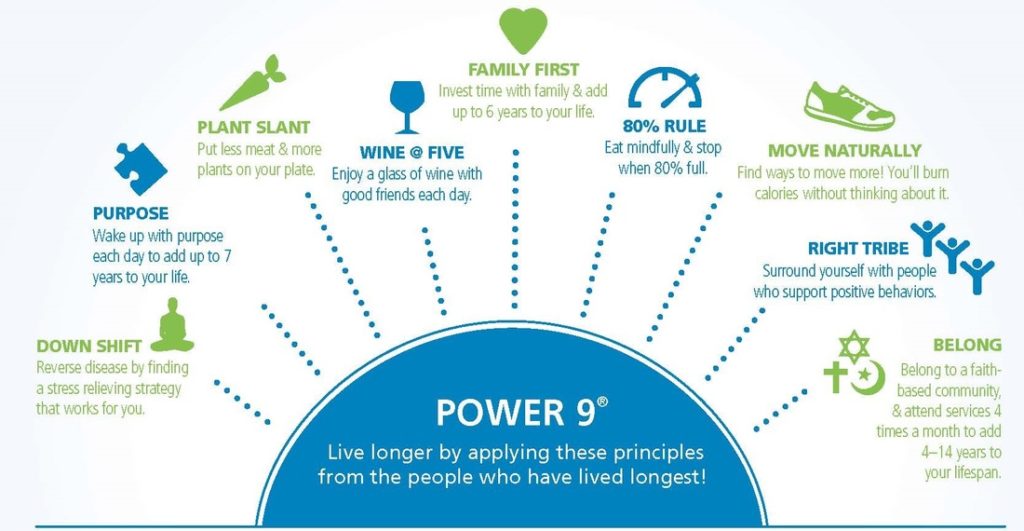How to Live Longer — Secrets of the Blue Zones

Eating well and exercising are obvious necessities for maximizing one’s lifespan, but many believe that genetics are actually the biggest determinant. But according to the Danish twin study, only 20 percent of longevity is due to hereditary causes. Based on this knowledge, Dan Buettner decided to figure out what it was exactly that contributed to a longer, healthier lifetime. He found there are “Blue Zones,” or areas throughout the world with high concentrations of healthy people living longer than most, due to specific lifestyle and environmental factors.
Where Are the Blue Zones?
Based on demographic research of global populations, Buettner identified five disparate regions having concentrations with health statistics that defied national or world averages. Things like lower rates of cardiovascular disease and cancer were defining factors, as well as abnormally high concentrations of centenarians – people who have lived past the age of 100.
Upon this realization, Buettner published his findings in National Geographic, and subsequently developed a set of guidelines emulating the intrinsic elements of these blue zone lifestyles, that could be applied to anyone.
In the United States, the average life expectancy is just over 78 years for the general population. Women have a higher expectancy than men by almost five years, which is pretty common across most cultures, but in certain “blue zones” life expectancy is significantly higher for both sexes, with residents consistently living into their 90s and beyond.

Sardinia, Italy is home to a region that, at the time of Buettner’s study, boasted the highest concentration of male centenarians in the world. Though mostly concentrated in one area of the island, the statistic was most prominent in a village called Seulo, part of a small mountainous region that was home to 20 blue zone centenarians from 1996-2016. But Seulo has barely maintained its top rank, often trading the title with Okinawa, Japan and the Nicoya Peninsula of Costa Rica.
Buettner visited these regions and studied the lifestyle habits of its denizens. In Sardinia, he noticed that the community was still living a Bronze Age lifestyle, where labor was intertwined with daily life and old age was celebrated.
One of the oldest men in the village was 104 years old and still able to beat Buettner in an arm-wrestling match. The man would wake up at 9 a.m., chop wood, drink a glass of wine, and give advice to a line of townspeople throughout the day, waiting for his wisdom.
This sense of community, regular, but moderate alcohol consumption, and physical activity were three important factors contributing to the Sardinians’ longevity. Their diet included high levels of Omega-3 fatty acids, vegetables, legumes and whole wheat, unleavened bread, and the wine they drank had three times the normal levels of polyphenols, their secret eau de vie.
The Blue Zones Longevity
The blue zone diet that was so beneficial to the Sardinians is a common theme across analogous communities. In the U.S., there is a blue zone just outside of Los Angeles in an area called Loma Linda. The town is home to a group of 7th Day Adventists, a conservative group of Christian Methodists. This community ascribes to a diet mentioned in the Bible that recommends eating mostly legumes, seeds, and green plants.

This is the foundation of the blue zone diet, a relative commonality between all of the communities Buettner studied. He found these people eat nutritious food at least 80 percent of the time, and they also make it a point not to overeat. In Okinawa there is a ritual prayer to remind themselves of this, recited before every meal. This anti-overindulgence mantra has been performed for 3,000 years since it was first uttered by Confucius.
Another secret to longevity that Buettner identified was that all of these communities had some sort of involvement in their community and participated in some type of sacred practice.
Whether it was religion or spirituality, these practices of faith typically lead to communal activity and a time set aside for a reprieve from life’s stresses. In Loma Linda the Christian community would celebrate their Sabbath from sunset on Friday to sunset on Saturday, allowing for a full 24 hours of what they referred to as a “sanctuary in time.”
Buettner said this slowing down, or taking time to downshift from life’s daily bustle, reduces an inflammatory response that our bodies kick into gear when we put stress on them. That inflammation has been linked to diseases like Alzheimer’s and heart disease, so when we regularly take action to reduce or eliminate that response, the results are overwhelmingly beneficial.
In Japan, friend groups were designated for an entire lifetime with groups of blue zone centenarians who got together regularly since their youth. These groups also helped in the anti-inflammatory unwinding process, while also providing a social outlet. They call these associations “Moais” which provide not just camaraderie, but support for times when they feel down or have something big going on in their lives.

Buettner recognized this across all of the blue zones and said that he believed this was the primary factor for achieving longevity, the foundation upon which every other lifestyle choice was built.
And nearly tantamount in its efficacy for a long, healthy life, he identified what the Okinawans call “Ikigai,” and the Costa Ricans call a “plan de vida” – a lifelong purpose. He found that devoting oneself to a passion or duty, not only provides a sense of direction and pride, but keeps your mind active and functioning.
You don’t have to move to these blue zones to dip into their fountain of youth tactics when Buettner has done the hard work of uncovering their secrets. By implementing some of these conscious lifestyle choices you too can reduce your risk of disease, live a healthier life, and maybe last long enough to join the centenarian club.
Study Claims Humans Can Live to 150 Years Old? But What's the Catch?

A new study on longevity says humans could live up to 150 years old. But does the science back up this claim?
A recent study by Singapore-based biotech firm GERO, examine the changes in blood cell counts and the number of steps taken by test subjects in the US, UK, and Russia. By studying these variables they found that people did not steadily decline as they age, but their resilience, or ability to bounce back from illness, stepped down over time. And barring disease or accidents, the maximum lifespan would be 150 years old when the body’s capacity for resilience would be exhausted.
Bill Andrews, president and CEO of Sierra Sciences, has studied anti-aging and telomeres for 30 years and is skeptical about this new claim.
“There have been at least five publications, and often times when I speak at conferences I’ll show those publications, in the last 25 years they’ve done a much better job of narrowing it down, and they’ve all come down to somewhere between 120 and 125 years,” Andrews said.
“Ok, so this new study that’s come out that claims 150 isn’t actually saying they’ve extended it out from 125 to 150, the accuracy of their data is not allowing them to give narrow answers. And when they contacted the press to make this press release about their study, they focused on the 150.”



































